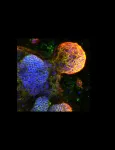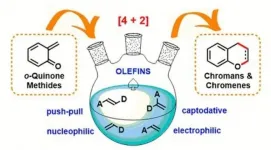(Press-News.org) A biomarker in the blood of patients with bowel cancer may provide valuable insight into the risk of cancer relapse after surgery and the effectiveness of chemotherapy.
Research published in PLOS found circulating tumour DNA (ctDNA) measured before and after surgery provided a reliable marker for predicting whether the cancer would recur following chemotherapy treatment.
The ctDNA also provided a real-time measure of the effectiveness of chemotherapy, highlighting the potential for this test to provide an early indication of the success of chemotherapy in eradicating microscopic cancer.
At a glance
By measuring levels of ctDNA present in the blood of bowel cancer patients after surgery, researchers were able to predict the likelihood of the cancer recurring.
Measuring the presence of ctDNA after chemotherapy provided a real time indication of whether the chemotherapy had cleared the cancer.
ctDNA could be used as a biomarker in the future to improve patient care and treatment
Prognostic impact of ctDNA
Led by Associate Professor Jeanne Tie, who is also a medical oncologist at the Peter MacCallum Cancer Centre and Western Health, the research followed a group of patients with metastatic bowel cancer who had secondary cancer in the liver that had been removed by surgery. The study builds on earlier research reported in 2018.
The ctDNA test looks for fragments of tumour DNA in a patient's blood before and after the removal of a cancerous tumour.
The presence of ctDNA in the blood of patients after surgery provides evidence of remaining microscopic tumours, enabling researchers to predict the likelihood of the cancer reoccurring.
Associate Professor Tie said the study once again confirmed the prognostic impact of ctDNA.
"What we found is that if ctDNA is present after surgery, it predicts an almost 100 per cent recurrence rate for these patients," she said.
"In contrast, for patients who were ctDNA-negative after surgery, the likelihood of the cancer reoccurring was far lower, about 25 per cent."
Measuring chemotherapy in real time
Associate Professor Tie said ctDNA also provided an indication of the effectiveness of chemotherapy.
"This biomarker could also identify whether patients would respond to chemotherapy treatment," she said.
"Until now, we had no way of measuring the effectiveness of chemotherapy in real time. The usual process is to do the surgery to remove the cancer metastases, give the patient chemotherapy, and then follow up with CT scans every six to 12 months, to see if the cancer recurs. And if the cancer does recur, you know the treatment hasn't worked. By measuring the ctDNA in the blood, we could immediately see whether the chemotherapy had cleared the cancer and were therefore able to predict the likelihood of the cancer recurring."
Associate Professor Tie said ctDNA biomarkers might allow clinicians to intervene earlier.
"Cancer that can be detected on a CT scan is unlikely to be curable by chemotherapy. But if we are able to detect microscopic disease, that we can't pick up on a scan, we can intervene earlier and potentially still offer the patient a chance of cure."
Promising sign for the future of cancer treatment
Associate Professor Tie said while ctDNA technology was already being used in the US, further research was needed before it could be rolled out in Australia.
"The test needs to be very sensitive to be able to pick up microscopic cancer cells. I am hopeful the new technology coming through will have enough sensitivity that we will be able to use this technique in the years ahead to improve patient care and treatment," she said.
"With further development of this technology, this could also mean patients with a low recurrence risk could avoid unnecessary chemotherapy."
INFORMATION:
This work was made possible with support from the National Institutes of Health, the Virginia and D.K Ludwig Fund for Cancer Research, the Victorian Cancer Agency Clinical Research Fellowship, the Victorian Government, the Sol Goldman Sequencing Facility at Johns Hopkins, and the John Templeton Foundation.
If insomnia keeps you awake at night, Flinders University researchers recommend a trip to the doctor - not for a sleeping pill prescription but for a short course of intensive behavioural therapy.
Researchers have developed new clinical guidelines for Australian doctors to give family GPs insights into the most effective treatment for insomnia - Cognitive Behavioural Therapy for insomnia (or 'CBTi').
CBTi improves insomnia, mental health and quality of life, and can be more successful than sleeping pills, say Adelaide Institute for Sleep Health (AISH) sleep experts from Flinders University in a new paper in the Australian Journal of General Practice.
Most patients with insomnia managed in general practice are prescribed potentially addictive ...
Paleo researcher Charlotte Prud'homme, who until recently worked at the Max Planck Institute for Chemistry and is now a researcher at the Université Lausanne, explains: "The 80-meter-thick sedimentary sequence we found at Charyn Canyon in southeast Kazakhstan provides us with a virtually continuous record of five million years of climate change. This is a very rare occurrence on land!" The alternating dust and soil layers provide the first reliable evidence, in one place, of long-term interactions between major climate systems on the Eurasian continent. "Over the past five million years, the land surfaces of Eurasia appear to ...
The so-called 'bullshit jobs theory' - which argues that a large and rapidly increasing number of workers are undertaking jobs that they themselves recognise as being useless and of no social value - contains several major flaws, argue researchers from the universities of Cambridge and Birmingham.
Even so, writing in Work, Employment and Society, the academics applaud its proponent, American anthropologist David Graeber, who died in September 2020, for highlighting the link between a sense of purpose in one's job and psychological wellbeing.
Graeber initially put forward the concept of 'bullshit jobs' - jobs that even those who do them view as worthless - in his 2013 essay ...
Researchers at the University of Turku, Finland, showed that the antibody treatment reactivates the immune defense in patients with advanced-stage cancer. The treatment alters the function of the body's phagocytes and facilitates extensive activation of the immune system.
The immune defense is the body's own defense system equipped to combat cancer. However, cancer learns to hide from immune attacks and harnesses this system to promote its own growth. Therefore, it would be beneficial to be able to return the immune defense back to restricting the advancement of cancer.
Macrophages, a type of white blood cell, are central in the fight against cancer. Cancer educates ...
RUDN University mathematician and his colleagues from France and Hungary developed an algorithm for parallel computing, which allows solving applied problems, such as electrodynamics or hydrodynamics. The gain in time is up to 50%. The results are published in the Journal of Computational and Applied Mathematics.
Parallel computing methods are often used to process practical problems in physics, engineering, biology, and other fields. It involves several processors joined in a net to simultaneously solve a single problem -- each has its own small part. The way to distribute the work between the processors and make them "communicate" with each other is a choice based on the specifics of a particular problem. ...
"Ornaments composed of elk teeth suspended from or sown on to clothing emit a loud rattling noise when moving," says auditory archaeologist and Academy of Finland Research Fellow Riitta Rainio from the University of Helsinki. "Wearing such rattlers while dancing makes it easier to immerse yourself in the soundscape, eventually letting the sound and rhythm take control of your movements. It is as if the dancer is led in the dance by someone."
Rainio is well versed in the topic, as she danced, for research purposes, for six consecutive hours, wearing elk tooth ornaments produced according to the Stone Age model. Rainio and artist Juha Valkeapää held a performance to ...
As G7 governments renew commitments to protecting marine spaces and biodiversity, global conservation initiatives such as 30x30 are feared to pay too little attention to the livelihood impacts on communities
Close-up inspection of an upcoming marine conservation area in Cambodia shows mixed livelihood consequences ranging from improving relationships to the state to increased anxiety and social division
In the long term and on a regional scale in Southeast Asia, communities exposed to marine conservation are poorer and experience higher child mortality
Researchers warn that the rapid global expansion of nominal marine protected area (MPA) coverage can undermine community livelihoods if it proceeds with a sole focus on marine resource conservation, a disregard of local ...
Physiologically, milk contains biocomponents that are highly protective against infections. In light of this, the AGR-149-Infectious Diseases group at the University of Cordoba's Department of Animal Health is doing research that focuses on cow's milk as a possible source of Covid-19 control. The results have been published, partially, in the journal Frontiers in Immunology.
This is possible due to "crossed immunity", and there is already evidence of the protection it provides, explained one of the principal investigators, Mari Carmen Borge. "It has been shown that the immune cells that the vaccinated animal generates against bovine coronavirus ...
O-quinone methides have been studied at the Samara Polytech for more than ten years. Vitaly Osyanin, Doctor of Chemistry, Professor of the Department of Organic Chemistry, is in charge of scientific work in this area. The results of the latest research were published in the authoritative Russian journal "Russian Chemical Reviews" (DOI: https://doi.org/10.1070/RCR4971).
Thus Professor Osyanin and the Candidate of Chemical Sciences, Associate Professor of the Department Dmitry Osipov and the Candidate of Chemical Sciences, the graduate of the Department Anton Lukashenko prepared a review article in which the main known examples of the transformation of o-quinone methides into chromene and ...
Skoltech scientists have studied the hydroxyl defects in LiFePO4, a widely used cathode material in commercial lithium-ion batteries, contributing to the overall understanding of the chemistry of this material. This work will help improve the LiFePO4 manufacturing process to avoid formation of adverse intrinsic structural defects which deteriorate its performance. The paper was published in the journal Inorganic Chemistry.
Lithium iron phosphate, LiFePO4, is a safe, stable and affordable cathode material for Li-ion batteries that has been very well optimized for practical applications despite its low conductivity and medium energy density. Yet scientists continue to study the various properties of this material, and in particular the impact ...




